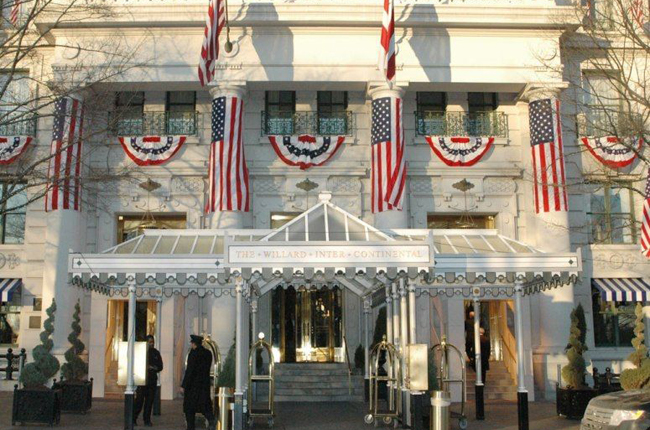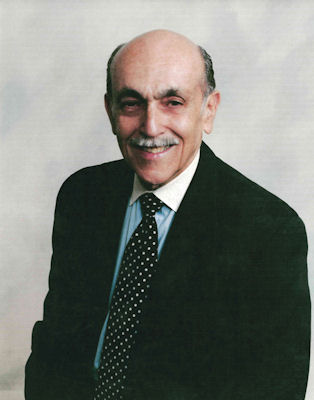
By Stanley Turkel, CMHS
1. Hotel History: The Willard Hotel (335 rooms)
The National Park Service and the U.S. Department of the Interior describe the history of the Willard Hotel as follows:
American author Nathaniel Hawthorne observed in the 1860s that "the Willard Hotel more justly could be called the center of Washington than either the Capitol or the White House or the State Department." From 1847 when the enterprising Willard brothers, Henry and Edwin, first set up as innkeepers on the corner of 14th Street and Pennsylvania Avenue, the Willard has occupied a unique niche in the history of Washington and the nation…. In 1847, Benjamin Ogle Tayloe leased the establishment to Henry A. Willard and his brother, Edwin…. In 1858, the Willards expanded again, purchasing the property of Col. James Kearney and built a six-story addition to the hotel….
At the beginning of the twentieth century, a new Willard Hotel was built by the George A. Fuller Company to the designs of the famous architect Henry Janeway Hardenbergh. In 1922, a major fire caused the evacuation by Vice President Calvin Coolidge, several U.S. Senators, composer John Philip Sousa, movie producer Adolph Zukor and other attendees at the annual Gridiron Dinner.
Presidents Taylor, Fillmore, Pierce, Buchanan, Lincoln, Grant, Taft, Wilson, Coolidge and Harding stayed at the Willard. Other notable guests have included Charles Dickens, Buffalo Bill, David Lloyd George, P.T. Barnum, and countless others. Walt Whitman included the Willard in his verses and Mark Twain wrote two books there in the early 1900s. It was Vice President Thomas R. Marshall, annoyed at the Willard's high prices, who coined the phrase "What this country needs is a good 5-cent cigar."
Situated just two blocks from the White House, the hotel is replete with the ghosts of the famous and powerful. Over the years it has been the gathering place for presidents, politicians, governors, literary and cultural figures. It was at the Willard that Julia Ward Howe composed "The Battle Hymn of the Republic." Gen. Ulysses S. Grant held court in the lobby and Abraham Lincoln borrowed house slippers from its proprietor. Mark Twain, Charles Dickens, Nathaniel Hawthorne and Jenny Lind were all part of the parade of celebrated Willard guests.
Even the uniquely political term "lobbyist" is said to have been coined at the Willard to describe those 19th century special-interest promoters who cornered politicians in the opulent Willard lobby.
The Willard sat vacant and in danger of demolition from 1968 until 1986 when it was restored to its former glory. A $73 million restoration project was carefully planned by the National Park Service to recreate the hotel as historically accurate as possible. Sixteen layers of paint were scraped from the woodwork to ascertain the hotel's original 1901 colors.
New York Times architecture critic Paul Goldberger wrote on September 22, 1986:
Most restorations of venerable buildings fall into one of two categories; They are either attempts to recreate as faithfully as possible what once was, or they are inventive interpretations that use the original architecture as a jumping-off point.
The newly rehabilitated Willard Hotel is both. Half of this project involves the respectful restoration of Washington's greatest hotel building, a distinguished Beaux-Arts structure by Henry Hardenbergh that had been derelict since 1968, a victim of the decline of its neighborhood, a few blocks east of the White House. The other half is an exuberantly conceived, brand new addition containing offices, shops, public plaza and a new ballroom for the hotel.
The hotel’s grand reopening in 1986 under the management of the InterContinental hotel chain – its full name is the Willard InterContinental Washington – was credited with rejuvenating downtown Washington.
The Willard InterContinental Washington is a member of Historic Hotels of America and the National Trust for Historic Preservation.
*Excerpted from my book “Built To Last: 100+ Year-Old Hotels East of the Mississippi” (AuthorHouse 2013)
2. Hot Off The Press: “Great American Hoteliers Volume 2: Pioneers of the Hotel Industry”
In his Foreword, Lawrence Horwitz, Executive Director of Historic Hotels of America describes my new book:
“If you have ever been in a hotel, as a guest, attended a conference, enjoyed a romantic dinner, celebrated a special occasion, or worked as a hotelier in the front or back of the house, Great American Hoteliers, Volume 2: Pioneers of the Hotel Industry is a must read book. This book is recommended for any business person, entrepreneur, student, or aspiring hotelier. This book is an excellent history book with insights into seventeen of the great innovators and visionaries of the hotel industry and their inspirational stories.”
Those seventeen great hotel innovators are:
Stewart Bainum, Sr., Curtis L. Carlson, Cecil B. Day, Louis J. Dinkler, Eugene C. Eppley, Roy C. Kelley, Arnold S. Kirkeby, Julius Manger, Robert R. Meyer, Albert Pick, Jr., Jay Pritzker, Harris Rosen, Ian Schrager, Vernon B. Stouffer, William C. Van Horne, Robert E. Woolley and Stephen A. Wynn.
If you want to order an autographed hardcover copy (with dust jacket), send a check for $36.00 to:
Stanley Turkel
147-03 Jewel Avenue
Flushing, N.Y. 11367
Be sure to include your mailing address.


